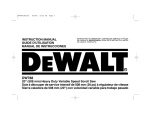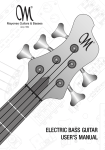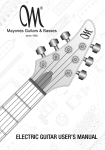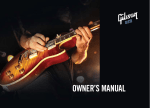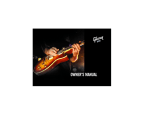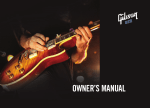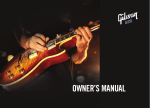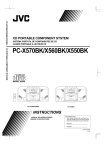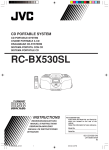Download Zon Sonus519 Operating instructions
Transcript
Contents G U I T A R S Owner’s Guide Operating Instructions and Warranty Sonus Legacy Mosaic GUITARS Birth certificate ........................................................................................2 Introduction ..............................................................................................3 Caring for your new Zon bass..................................................................4 Adjustments..............................................................................................5 Bridge ................................................................................................5 Pickups ..............................................................................................6 About set-up........................................................................................8 Important note about truss rod adjustment ........................................9 Truss rod adjustment for Mosaic ........................................................9 Truss rod adjustment for Mosaic Pro................................................10 Electronics ..............................................................................................11 ZP-2S................................................................................................12 ZP-2D & ZP-2DM..............................................................................14 ZP-3D ..............................................................................................16 Internal controls ..........................................................................18 Piezo EQ ....................................................................................18 ZP-4 ..................................................................................................20 ZB-2 ..................................................................................................22 ZB-3 ..................................................................................................24 ZB-4.0 & ZB-4.3................................................................................26 ZB-5 ..................................................................................................28 ZB-6 ..................................................................................................30 ZDP 1 & ZAP-3 ................................................................................32 ZAP-1................................................................................................34 S2 Lightwave ....................................................................................35 Calibration instructions for S2 Lightwave system ......................37 Piezo voicing DIP switch settings ..............................................37 Preliminary optical alignment ......................................................39 Intonation ....................................................................................39 Warranty ................................................................................................40 Parts & Update Information ....................................................................40 © 2005 Zon Guitars. 1 Birth Certificate GUITARS Model: Thank you for making your choice a ZON bass. Crafted by artisans with a passion for building each instrument as if it was their very own, your bass is the culmination of classic hand-craftsmanship and the best in contemporary materials. Serial number: Date of manufacture: The neck and body of your bass were completely crafted in our Redwood City facility. The import models are carefully scrutinized in our facility to meet our standards of quality. This meticulous attention to detail, comfort and aesthetics is our hallmark, ensuring you a bass with a lifetime of reliable service and playing enjoyment. Color: Woods: Core Pickups: Top Electronics: ZP-2S / ZP-2D / ZP-2DM / ZP-3 / ZP-4 ZB-2/ ZB-3 / ZB-4.0 / ZB-4.3 / ZB-5 / ZB-6 / ZDP-1 / ZAP-3 / ZAP-1 / Lightwave S2 Careful thought has been put into the design and creation of each model we offer. Each component is selected to work with and complement the other in order to achieve the distinctive voice prescribed for that particular model bass. Pickups and electronics are designed exclusively for Zon and made to our specifications from the highest-quality components. The hardware is machined to precision tolerances in order to facilitate accurate, stable tuning and micro-fine adjustments. Hand-selected, premium-grade woods were used in the construction of your instrument and finished by hand to achieve a lasting beauty. The fretwork is also dressed by hand, and the instrument thoroughly set-up, adjusted and tested prior to shipment, ensuring a bass with optimum playability and performance. Final inspection by Zon Guitars 780 Second Ave. Redwood City, CA 94063 USA Telephone: 650-366-3516 Fax: 650-366-9996 Email: [email protected] http://www.zonguitars.com 2 Introduction GUITARS The contents of this Owner’s Guide are filled with valuable information about your new instrument. Please read it carefully to learn how to care for your bass and before making any adjustments. If you are uncomfortable with any of the procedures contained in this manual, take your instrument to a qualified repairperson. In the event you should need special assistance, please contact us at toll free at 1 877 PLAY ZON or via the web at www.zonguitars.com. Sincerely, Joseph M. Zon President, Zon Guitars 3 GUITARS Caring For Your New Zon Bass By design, your bass is virtually maintenance-free, making it a consistently reliable tool. Here are a few things that will help preserve the beauty and performance of this instrument for years to come. General Avoid exposure to extreme temperature changes. When bringing your bass inside from a cold environment, keep the case closed. Allow the instrument to acclimate by waiting until the case warms to room temperature before opening it. This will allow the instrument’s wood and finish to expand at the same rate, preventing the finish from shattering. Likewise, do not leave your instrument in direct sunlight or in the trunk of a car on a hot day. Temperatures in a car trunk can exceed 212 degrees F (100 degrees C). Extended exposure to this condition can cause severe damage to the instrument. Periodically check all the screws and string saddles to make sure everything is tightened snug and working properly. Finish The finish on your bass is a catalyzed polyester coating, formulated to be impervious to moisture and far more durable than lacquer. It can be cleaned using Zon Finesse, a cleaner specially made for this type of finish. Do not use furniture polish or cleaners on your bass, they build up and turn gummy. Fingerboard Cleaning the phenowood fingerboard on our composite necks can be done using a small drop of WD-40 on a cloth and working it into the surface. Cleaning the rosewood/pau ferro fingerboard on our wood necks can be done using a small amount of lemon oil and working it into the wood grain. Adjustments GUITARS Your instrument has been completely adjusted and set up by our technicians. Due to shipping, personal playing preferences and circumstances beyond our control, some minor adjustments may be required. If you are inexperienced with any of the following procedures, take your instrument to a qualified repairperson. The adjustments in this book are for reference purposes only. Zon Guitars assumes no liability for damage to the instrument caused by improper adjustments or modifications as a result of viewing this information. Bridge Your instrument is equipped with a two-way adjustable Zon bridge. Adjustments to this bridge optimize string height and intonation. Fig. 1. Turning each saddle’s hex screws adjusts the string height. Adjusting string height. Insert the 1.5mm hex key (supplied) into one of the small hex screws saddle heights located at the corner on each side of the saddles’ leading edge (see Fig. 1). Turning the hex key clockwise fingerboard radius raises the saddle, increasing string height. Turning counterclockwise lowers the saddle, Fig. 2. Adjust saddle heights to match decreasing string height. It is the fingerboard radius. important that the saddle heights follow the fingerboard radius for proper playability (see Fig. 2). To check this, sight down the fingerboard from the nut toward the bridge and make sure that the saddles follow the curvature of the fingerboard. Setting intonation. Adjust the Fig. 3. Turning each saddle’s travel Phillips-head travel screw on the screw adjusts the string’s intonation. 4 5 GUITARS GUITARS bridge’s back edge (Fig. 3). Rotating this screw counterclockwise moves the saddle forward (toward the neck), causing the string pitch to raise (become sharp). Rotating the screw clockwise moves the saddle backward (toward the bridge), causing the string’s pitch to lower (become flat). The instrument is perfectly intonated when the harmonic at the 12th fret and the fretted note at the 12th fret are equal in pitch. Adjusting the soapbar-style pickups (Fig. 5 & 6). To begin, the mounting of these pickups was designed to eliminate springs and provide a rigid fix to the body. In this design, two screws on the pickup’s face pull down while two screws located through two holes in the pickup push up. For more information on adjustments, visit the Zon Guitars web site, at http://www.zonguitars.com. Turn screws to adjust height Pickups The pickups on your bass should be set for equal balance of volume from the neck to the bridge position, as well as from string to string. The pickups should be set close to the strings for maximum output, but not so close that the strings contact the pickup surface when played. String contact with the pickup will mar the surface and send unwanted transients through your amp, possibly causing damage to it. Please note: When adjusting pickup heights, care should be taken not to overtighten the screws, as damage may occur to the pickup. Fig. 5. Two screws adjust the pickup height, while two lock the pickup in place. Adjusting the narrow-bar-style pickups (Fig. 4). With a small Phillips-head screwdriver, adjust the screws located on either edge of Turning this screw raises and lowers the pickup height. Turn screws to adjust height Fig. 4. Turning each screw clockwise lowers its side of the pickup, while turning counterclockwise raises it. the pickup to achieve the desired height. Clockwise rotation of the screw lowers the pickup. Counterclockwise rotation raises the pickup. The machine screws used to secure the pickups feed into threaded inserts set into the body. This provides smooth adjustment and prevents the screw from stripping the hole, a common problem when regular wood screws are used. 6 Threaded insert Bass body Turning this screw locks the pickup in place. Threaded insert Fig. 6. Turning each screw clockwise lowers its corner of the pickup, while turning counterclockwise raises it. 7 GUITARS With a medium Phillips-head screwdriver, locate the screws on the pickup’s upper treble-side corner and lower bass-side corner. Rotate these screws counterclockwise—just enough to break them free. Next, locate the holes at the pickup’s lower treble-side corner and upper bass-side corner. Insert a #0 Phillips-head screwdriver into the holes, alternately rotating the screws clockwise to lower the pickup or counterclockwise to raise the pickup. By manipulating the screws’ height, different angles of pitch to the pickup can be achieved, helping to fine-tune the pickup’s positioning and balance. Adjusting 3-screw pickups. Zon Sonus 4/1, 4/2, 5/1, 5/2 basses are equipped with pickups that have three adjustment screws—two on the Turn screws to adjust height About Set-Up GUITARS The amount of neck relief is a personal choice as different playing styles require different string action. Too little relief, and the frets will buzz. Too much relief, and the bass will be difficult to play. General Our composite necks do not require any adjustment. They are designed to provide proper playing relief without the aid of a truss rod. However, our wood necks will require periodic adjustment with seasonal changes. Before making a truss rod adjustment, assess the direction of adjustment by sighting down the edge of the fingerboard from the string nut to heel. Curvature of the fingerboard away from the string indicates underbow. Curvature toward the string indicates overbow. Ideally, the neck should have a slight amount of underbow, just shy of being straight. If adjusted properly, this will provide low action with minimal fret noise. For even less fret noise and more challenging action, add relief. These adjustments can be made with the strings at normal tension. Important Note About Truss Rod Adjustment Be careful not to overtighten the adjusting nut. Doing so could strip the rod, making it useless. If you feel uncomfortable making these adjustments, contact an experienced repairperson. Fig. 7. Turning each screw clockwise lowers its corner of the pickup, while turning counterclockwise raises it. bass side and one on the treble side. With a small Phillips-head screwdriver, adjust the screws located on either edge of the pickup to achieve the desired height. Clockwise rotation of the screw lowers the pickup. Counterclockwise rotation raises the pickup. The machine screws used to secure the pickups feed into threaded inserts set into the body. This provides smooth adjustment and prevents the screw from stripping the hole, a common problem when regular wood screws are used. 8 Truss Rod Adjustment Truss rods are installed in the necks of the Mosaic and Mosaic Pro to facilitate the correction of neck relief (overbow or underbow) caused by string tension and/or changes in temperature and humidity. The amount of relief in either direction directly affects the instrument’s string height and playability. 9 Mosaic GUITARS This model has one dual-action truss rod, which allows the neck to be adjusted in either direction. Therefore, it is possible to compensate for underbow or overbow. Making adjustments. Remove the cover plate behind the string nut on your instrument. Using the 4mm hex wrench supplied with your instrument, turn the adjusting nut clockwise to decrease the amount of relief and straighten the neck, Fig. 8. Turn the single hex adjustment nut on the Mosaic small amounts to or counterclockwise to adjust relief and straightness. increase the amount of relief, giving the neck underbow. Mosaic Pro This model has a single rod for neck adjustment. Dual graphite bars embedded in this neck add extra stiffness and assist the truss rod in providing a balanced adjustment. Making adjustments. Locate the adjustment nut at the heel of the neck. Using the 9/64" hex wrench supplied with your instrument, turn the adjusting nut clockwise to decrease the amount of relief and straight- Fig. 9. Turn the Mosaic Pro’s single en the neck, or counterclock- adjustment nut to set the amount of relief and straightness. wise to increase the amount of relief giving the neck underbow. 10 Electronics GUITARS The electronics on your Zon bass are made to provide you with versatility and optimal tonal shaping. Each “package” is designed to work in conjunction with and complement the other components of the instrument so that the “sum of all the parts” will culminate in the distinctive voice prescribed for that particular model. General All of our active electronics use the highest-quality components for lownoise, long-term use and reliability. Power consumption varies with each circuit, depending on the complexity of its functions. Low power reserves are indicated by a loss of output and an increase in noise or distortion. To remedy this situation, change the battery (or batteries). Before changing the batteries, be sure the cable is not plugged into the output jack of the bass. Remove the backplate screws and cover, and then unclip the battery from the harness. Be careful not to yank the harness, as this action may cause the wires to break from their connections. Transfer the foam jacket (which helps prevent the metal case of the battery from shorting the components) from the old battery onto the new one and attach the harness connector in place. Install the backplate and connect the guitar cable to test. Note: To prolong battery life, unplug your instrument when you are not playing. If your bass requires two batteries, always change both of them at the same time. Warning: Replace the battery with a good-quality 9-volt alkaline. Do not use rechargeable batteries. 11 ZP-2S Description: GUITARS GUITARS MODEL: Hyperbass Function: Specifications: Power requirements: Bass Class A design with studio-grade components on a printed circuit board Volume Active master volume, bass, treble, and internal midrange boost/cut Treble Output level +16dBm, S/N ratio 100dB One 9-volt battery Battery life expectancy: 200 hours continuous use Volume control. Unlike passive volume controls, which decrease the volume by shorting some of the signal to ground, causing degradation in tone, the active volume control on the ZP2 allows the volume to be set to any level without overall loss of highs or tonal change. Play a note, let it ring while slowly turning this control up and down, and you’ll hear no change in tone. Bass control. 15dB boost or cut of bass at a center frequency of 30 Hz. Turning the control clockwise boosts the bass. Turning the control counterclockwise cuts the bass. The detent, or “click,” in the center of the control is the “flat” position, zero boost or cut. Midrange control (internal). 15dB boost or cut of midrange at a center frequency of 330 Hz. Turning the control clockwise boosts the mids. Turning the control counterclockwise cuts the mids. The midpoint in the control’s sweep is the “flat” position, zero boost or cut. 9-Volt Battery About the system MAG MID Midrange Treble control. 15dB boost or cut of treble at a center frequency of 3kHz. Turning the control clockwise boosts the treble. Turning the control counterclockwise cuts the treble. The detent, or “click,” in the center of the control is the “flat” position, zero boost or cut. 12 13 GUITARS ZP-2D & ZP-2DM Description: MODELS: Sonus Custom, Legacy Elite, Legacy Elite Special Function: Specifications: Power requirements: Class A design with studio-grade components on a printed circuit board Active master volume, pickup blend. Bass, treble and internal midrange boost/cut GUITARS the ZP-2DM, the midrange control is a knob on the instrument’s face. Turning the control clockwise boosts the mids. Turning the control counterclockwise cuts the mids. A detent, or “click,” in the center of the control is the “flat” position, zero boost or cut. Treble control. 15dB boost or cut of treble at a center frequency of 3kHz. Turning the control clockwise boosts the treble. Turning the control counterclockwise cuts the treble. The detent, or “click,” in the center of the control is the “flat” position, zero boost or cut. Output level +16dBm. S/N ratio 100dB One 9-volt battery Bass Battery life expectancy: 200 hours continuous use Master volume About the system Midrange (ZP-2DM only) Volume control. Unlike passive volume controls, which decrease the volume by shorting some of the signal to ground, causing degradation in tone, the active volume control on the ZP2 allows the volume to be set to any level without overall loss of highs or tonal change. Play a note, let it ring while slowly turning this control up and down, and you’ll hear no change in tone. Bass control. 15dB boost or cut of bass at a center frequency of 30 Hz. Turning the control clockwise boosts the bass. Turning the control counterclockwise cuts the bass. The detent, or “click,” in the center of the control is the “flat” position, zero boost or cut. Midrange control. 15dB boost or cut of midrange at a center frequency of 330 Hz. On basses equipped with the ZP-2D, the midrange control is an internal trimmer on the circuit board. Turning the control clockwise boosts the mids. Turning the control counterclockwise cuts the mids. The midpoint in the control’s sweep is the “flat” position, zero boost or cut. (You will need to remove the control cavity’s cover plate to adjust this control.) On basses equipped with 14 Treble 9-Volt Battery Pickup blend control. Buffered inputs provide exacting control over blending the neck and bridge pickups. This feature allows even the most subtle blend, for a greater variety of tone. Turning the control clockwise brings in the bridge pickup. Turning the control counterclockwise brings in the neck pickup. The detent, or “click,” in the center of the control is the point where both pickups are on equally. Pickup blend MAG MID Midrange (ZP-2D only) 15 ZP-3D Description: GUITARS MODELS: Sonus Custom & Legacy Elite w/piezo Function: Magnetics: Piezo: Specifications: Power requirements: Class A design with studio-grade components on a printed circuit board Active master volume, pickup blend, magnetic/piezo blend Bass, treble and internal midrange boost/cut with center frequency switch for mids and treble GUITARS mined by the switch selection. Turning the control clockwise boosts the treble. Turning the control counterclockwise cuts the treble. The detent, or “click,” in the center of the control is the “flat” position, zero boost or cut. Piezo blend control. Provides the ability to continuously blend the signal from piezo bridge and the magnetic pickups. Turning the control clockwise alters the balance between piezo and magnetic pickups by emphasizing the magnetic signal while de-emphasizing the piezo. Turning the control counterclockwise de-emphasizes the magnetic pickups while emphasizing the piezo. Level, bass, and treble gain controls Output level -10dBm One 9-volt battery Battery life expectancy: 200 hours continuous use About the system Volume control. Unlike passive volume controls which decrease the volume by shorting some of the signal to ground, causing degradation in tone, the active volume control on the ZP3 allows the volume to be set to any level without overall loss of highs or tonal change. Play a note, let it ring while slowly turning this control up and down, you’ll hear no change in tone. Bass Master volume Treble Pickup blend Piezo Blend Pickup blend control. Buffered inputs provide exacting control over blending the neck and bridge magnetic pickups. This feature allows even the most subtle blend, for a greater variety of tone. Turning the control clockwise brings in the bridge pickup. Turning the control counterclockwise brings in the neck pickup. The detent, or “click,” in the center of the control is the point where both pickups are on equally. Bass control.15dB boost or cut of bass at a center frequency of 30Hz. Turning the control clockwise boosts the bass. Turning the control counterclockwise cuts the bass. The detent, or “click,” in the center of the control is the “flat” position, zero boost or cut. Treble control. 15dB boost or cut of treble at a center frequency deter- 16 ZP-3D “About The System” continues on page 18 17 GUITARS GUITARS ZP-3D continued Treble switch Internal Controls Magnetic Pickup EQ Midrange switch. Select from 150 Hz, 250 Hz, 400 Hz, or 700 Hz as the center frequency from which to boost or cut. High frequency switch. Select from 1.5kHz, 3.0kHz, 4.5kHz, or 7.0kHz as the center frequency from which to boost or cut. Midrange control. 15dB boost or cut of midrange at a center frequency selected by the midrange switch position. Turning the control clockwise boosts the mids. Turning the control counterclockwise cuts the mids. The midpoint in the control’s sweep is the “flat” position, zero boost or cut. Piezo EQ P TREBLE 9-Volt Battery The following controls are located inside the bass’ control cavity. You will need to remove the rear cover plate to adjust them. Piezo treble control HI 7.0k 4.5k 3.0k 1.5k MID 700 400 250 150 Midrange switch P LEVEL P BASS MAG MID Piezo bass control Piezo gain control Internal magnetic midrange control P level. Piezo gain control. Turn control up or down to adjust the ratio of piezo output to magnetic output. P bass. Bass gain control. Turning the control clockwise increases bass, turning the control counterclockwise decreases bass. P treble. Treble gain control. Turning the control clockwise increases treble, turning the control counterclockwise decreases treble. 18 19 ZP-4 Description: GUITARS MODELS: Sonus 4/2 & 5/2 Function: Specifications: Power requirements: Class A design with studio-grade components on a printed circuit board Active master volume, pickup blend. Bass, treble and internal midrange boost/cut GUITARS trol is the “flat” position, zero boost or cut. Gain trimmer. Attenuates overall output level. Factory setting is mid position. Caution: Setting gain too high may cause distortion. 08 Output level +16dBm. S/N ratio 100dB Master volume One 9-volt battery Battery life expectancy: 200 hours continuous use Pickup blend About the system Volume control. Unlike passive volume controls that decrease the volume by shorting some of the signal to ground, causing degradation in tone, the active volume control on the ZP4.3 allows the volume to be set to any level without overall loss of highs or tonal change. Play a note, let it ring while slowly turning this control up and down, and you’ll hear no change in tone. Bass (outer ring) Treble (center) Pickup blend control. Buffered inputs provide exacting control over blending the neck and bridge pickups. This feature allows even the most subtle blend, for a greater variety of tone. Turning the control clockwise brings in the bridge pickup. Turning the control counterclockwise brings in the neck pickup. The detent, or “click,” in the center of the control is the point where both pickups are on equally. GAIN TRIM MID FREQ ry te t Ba Internal midrange control. 15dB boost or cut of midrange at a center frequency of 330 Hz. Turning the control clockwise boosts the mids. Turning the control counterclockwise cuts the mids. The midpoint in the control’s sweep is the “flat” position, zero boost or cut. Internal midrange control lt Vo 9- Bass control. 15dB boost or cut of bass at a center frequency of 30 Hz. Turning the control clockwise boosts the bass. Turning the control counterclockwise cuts the bass. The detent, or “click,” in the center of the control is the “flat” position, zero boost or cut. Gain trimmer Treble control. 15dB boost or cut of treble at a center frequency of 3kHz. Turning the control clockwise boosts the treble. Turning the control counterclockwise cuts the treble. The detent, or “click,” in the center of the con- 20 21 ZB-2 GUITARS GUITARS MODELS: Sonus 4/1 & 5/1 Description: Function: Specifications: Power requirements: Battery life expectancy: About the system Hand-assembled components housed in an electrostatically shielded, epoxy module Master volume Master volume, bass and treble boost/cut Output level N/A Bass (outer ring) One 9-volt battery Treble (center) 500 hours continuous use 05 Master volume control. Controls overall volume level. Turning the control clockwise increases the volume; turning the control counterclockwise decreases the volume. Bass control. 15dB boost or cut of bass at a center frequency of 50 Hz. Turning the control clockwise boosts the bass; turning the control counterclockwise cuts the bass. The detent, or “click,” in the center of the control is the “flat” position, zero boost or cut. Treble control. 15dB boost or cut of treble at a center frequency of 5kHz. Turning the control clockwise boosts the treble; turning the control counterclockwise cuts the treble. The detent, or “click,” in the center of the control is the “flat” position, zero boost or cut. Trimmer sets maximum gain 9- Vo lt Ba tte ry Trimmer. This control on the circuit module attenuates overall output level. Its factory setting is the mid position. Caution: Setting gain too high may cause distortion. 22 23 ZB-3 GUITARS GUITARS 08 MODELS: Sonus 4, 5, 6, 8 & Special Description: Function: Specifications: Power requirements: Master volume Hand-assembled components housed in an electrostatically shielded, epoxy module Master volume, pickup blend, bass and treble boost/cut Pickup blend Output level -10dBm One 9-volt battery Bass (outer ring) Battery life expectancy: 500 hours continuous use About the system Treble (center) Master volume control Controls overall volume level. Turning the control clockwise increases the volume; turning the control counterclockwise decreases the volume. 05 Pickup blend control. Controls relative blend of pickups. Turning the control clockwise emphasizes the bridge pickup. Turning the control counterclockwise emphasizes the neck pickup. The detent, or “click,” in the center of the control is the point where both pickups are on equally. Bass control. 15dB. boost or cut of bass at a center frequency of 50Hz. Turning the control clockwise boosts the bass. Turning the control counterclockwise cuts the bass. The detent, or “click,” in the center of the control is the “flat” position, zero boost or cut. Treble control. 15dB boost or cut of treble at a center frequency of 5kHz. Turning the control clockwise boosts the treble. Turning the control counterclockwise cuts the treble. The detent, or “click,” in the center of the control is the “flat” position, zero boost or cut. Trimmer sets maximum gain 9- Vo lt Ba tte ry Trimmer. This control on the circuit module attenuates overall output level. Its factory setting is the mid position. Caution: Setting gain too high may cause distortion. 24 25 ZB-4.0 GUITARS (Sonus RT & RT Deluxe) Description: Function: Specifications: Power requirements: & ZB-4.3 GUITARS (Sonus 519) Hand-assembled components housed in an electrostatically shielded, epoxy module Master volume, pickup blend, bass, midrange, and treble boost/cut with 3-position midrange frequency switch Mid frequency switch. Down position @ 250 Hz. Center position @ 400 Hz. Up position @ 700 Hz. Trimmer. This control on the circuit module attenuates overall output level. Its factory setting is the mid position. Caution: Setting gain too high may cause distortion. Master volume Output level -10dBm Mid frequency switch (ZB-4.3 only) One 9-volt battery Battery life expectancy: 500 hours continuous use Pickup blend About the system Midrange Master volume control. Controls overall volume level. Turning the control clockwise increases the volume; turning the control counterclockwise decreases the volume. Pickup blend control. Controls relative blend of pickups. Turning the control clockwise emphasizes the bridge pickup. Turning the control counterclockwise emphasizes the neck pickup. The detent, or “click,” in the center of the control is the point where both pickups are on equally. Bass control. 15dB boost or cut of bass at a center frequency of 50 Hz. Turning the control clockwise boosts the bass. Turning the control counterclockwise cuts the bass. The detent, or “click,” in the center of the control is the “flat” position, zero boost or cut. Midrange control. 15dB boost or cut of midrange at a center frequency determined by the switch selection. Turning the control clockwise boosts the mids. Turning the control counterclockwise cuts the mids. The detent, or “click,” in the center of the control is the “flat” position, zero boost or cut. Treble control. 15dB boost or cut of treble at a center frequency of 5kHz. Turning the control clockwise boosts the treble. Turning the control counterclockwise cuts the treble. The detent, or “click,” in the center of the control is the “flat” position, zero boost or cut. 26 Bass (outer ring) Treble (center) Trimmer sets pickup input level (ZB-4.0 only) Trimmer attenuates overall output level 9- Vo l tB at te ry 27 ZB-5 Description: GUITARS MODELS: VB4 & VB5 Function: Specifications: Power requirements: Hand-assembled components housed in an electrostatically shielded, epoxy module Master volume, pickup blend, bass, mid and treble boost/cut with push/pull selectable midrange frequency Output level N/A One 9-volt battery Battery life expectancy: 500 hours continuous use About the system Master volume control. Controls overall volume level. Turning the control clockwise increases the volume; turning the control counterclockwise decreases the volume. Pickup blend control. Controls relative blend of pickups. Turning the control clockwise emphasizes the bridge pickup. Turning the control counterclockwise emphasizes the neck pickup. The detent, or “click,” in the center of the control is the point where both pickups are on equally. Bass control. 15dB boost or cut of bass at a center frequency of 50 Hz. Turning the control clockwise boosts the bass, turning the control counterclockwise cuts the bass. The detent, or “click,” in the center of the control is the “flat” position, zero boost or cut. GUITARS Trimmer. This control on the circuit module attenuates overall output level. Its factory setting is the mid position. Caution: Setting gain too high may cause distortion. Bass Master volume Midrange (push/pull) Treble Pickup blend Trimmer attenuates overall output level Midrange control. 15dB boost or cut of midrange at 250 Hz with knob in “up” (push/pull pot) position and at 800 Hz with knob in “down” position. Turning the control clockwise boosts the mids. Turning the control counterclockwise cuts the mids. The detent, or “click,” in the center of the control is the “flat” position, zero boost or cut. Treble control. 15dB boost or cut of treble at a center frequency of 5kHz. Turning the control clockwise boosts the treble, turning the control counterclockwise cuts the treble. The detent, or “click,” in the center of the control is the “flat” position, zero boost or cut. 28 29 ZB-6 Description: GUITARS MODEL: Sonus Studio Function: Specifications: Power requirements: Hand-assembled components housed in an electrostatically shielded, epoxy module Master volume, pickup blend, bass and treble boost/cut with 3-position boost switch for each pickup Output level -16dBm Two 9-volt batteries GUITARS Neck pickup treble trimmer. Attenuates treble for 3-position boost switch. Bridge pickup treble trimmer. Attenuates level of treble for 3-position boost switch. Neck pickup output trimmer. Attenuates overall output level of neck pickup. Its factory setting is mid position. Bridge pickup output trimmer. Attenuates overall output level of bridge pickup. Its factory setting is mid position. Caution: Setting gain too high may cause distortion. Battery life expectancy: 250 hours continuous use About the system Neck-pickup boost switch Master volume control. Controls overall volume level. Turning the control clockwise increases the volume; turning the control counterclockwise decreases the volume. Bridge-pickup boost switch Neck-pickup treble (center) Pickup blend control. Controls relative blend of pickups. Turning the control clockwise emphasizes the bridge pickup. Turning the control counterclockwise emphasizes the neck pickup. The detent, or “click,” in the center of the control is the point where both pickups are on equally. Neck pickup boost switch. Down position: mid boost @ 450 Hz. Up position: boost mids @ 450 Hz and treble at 3kHz. Center position: flat, zero boost. Bridge pickup boost switch. Down position: mid boost @ 450 Hz. Up position: boost mids @ 450 Hz and treble at 3kHz. Center position: flat, zero boost. 30 Bridge-pickup treble (center) Bridge-pickup bass (outer ring) Pickup blend Neck-pickup treble trimmer Neck-pickup output trimmer Bridge pickup treble trimmer 9-Volt Battery Treble control (neck and bridge). 15dB boost or cut of treble at a center frequency of 5kHz.Turning the control clockwise boosts the treble. Turning the control counterclockwise cuts the treble. The detent, or “click,” in the center of the control is the “flat” position, zero boost or cut. Master volume 9-Volt Battery Bass control (neck and bridge). 15dB boost or cut of bass at a center frequency of 50 Hz. Turning the control clockwise boosts the bass.Turning the control counterclockwise cuts the bass. The detent, or “click,” in the center of the control is the “flat” position, zero boost or cut. Neck-pickup bass (outer ring) Bridge-pickup output trimmer 31 ZDP-1 GUITARS (Mosaic) Description: & ZAP3 Function: Specifications: Power requirements: (Mosaic Pro) Hand-assembled components housed in an electrostatically shielded, epoxy module Master volume, pickup blend, bass, mid and treble boost/cut Output level N/A Two 9-volt batteries Battery life expectancy: 300 hours continuous use About the system GUITARS Bass boost/cut Mid boost/cut Treble boost/cut Master volume Pickup blend Master volume control. Controls overall volume level. Turning the control clockwise increases the volume; turning the control counterclockwise decreases the volume. Pickup blend control. Controls relative blend of pickups. Turning the control clockwise emphasizes the bridge pickup. Turning the control counterclockwise emphasizes the neck pickup. The detent, or “click,” in the center of the control is the point where both pickups are on equally. Bass control. 15dB boost or cut of bass at a center frequency of 50 Hz. Turning the control clockwise boosts the bass. Turning the control counterclockwise cuts the bass. The detent, or “click,” in the center of the control is the “flat” position, zero boost or cut. Midrange control. 15dB boost or cut of midrange at 400 Hz. Turning the control clockwise boosts the mids; turning the control counterclockwise cuts the mids. The detent, or “click,” in the center of the control is the “flat” position, zero boost or cut. Treble control. 15dB boost or cut of treble at a center frequency of 5kHz. Turning the control clockwise boosts the treble. Turning the control counterclockwise cuts the treble. The detent, or “click,” in the center of the control is the “flat” position, zero boost or cut. 32 33 ZAP-1 Description: GUITARS MODELS: Sonus Classic 4 & 5 Function: Power requirements: Description: Infrared light pickup system with piezo elements. N/A Specifications: N/A One 9-volt battery Battery life expectancy: 500 hours continuous use About the system Neck-pickup volume control. Buffered volume control for neck pickup, will not interact with other controls.Turning the control clockwise increases the volume; turning the control counterclockwise decreases the volume. Bridge-pickup volume control. Buffered volume control for bridge pickup, will not interact with other controls. Turning the control clockwise increases the volume; turning the control counterclockwise decreases the volume. Bass/treble control. 12 dB boost of bass and treble at a center frequency of 40 Hz and 4kHz respectively. Turning the outer ring of the control control clockwise increases the bass. Turning it counterclockwise decreases the bass. Turning the knob of the control clockwise increases the treble. Turning it counterclockwise decreases the treble. Neck-pickup volume Bridge-pickup volume Treble control (center) Bass control (outer ring) Output 34 MODELS Sonus Lightwave 4, 5 & 6 Hand-assembled components housed in an electrostatically shielded, epoxy module Volume (neck pickup),Volume (bridge pickup). Concentric bass/treble control Specifications: S2 GUITARS Function: Power requirements: Master volume, bass and midrange boost/cut, mid sweep, piezo (Icetone) blend controls 18-volt NiMH battery. Battery life expectancy: 15 hours of continuous play time between charges About the system Master volume control. Controls the overall volume level of optical and piezo pickups. Turning the control clockwise raises the volume. Turning the control counterclockwise lowers the volume. Bass control. 12dB boost or cut of bass. Turning the control clockwise boosts the bass. Turning the control counterclockwise cuts the bass. The detent, or “click,” in the center of the control is the “flat” position, zero boost or cut. Volume Bass Mid boost/cut Midrange sweep Icetone 35 GUITARS GUITARS Midrange control. 12dB boost or cut of midrange at a frequency selected by the mid sweep control. Turning the control clockwise boosts the mids. Turning the control counterclockwise cuts the mids. The detent, or “click,” in the center of the control is the “flat” position, zero boost or cut. Midrange sweep control. Provides a variable Q that is narrow in the low frequencies and increasingly broad in the higher frequencies. Turning the control from the fully counterclockwise position to the fully clockwise position references (sweeps) frequencies from 200 Hz to 1,000 Hz. The detent, or “click,” in the center of the knob’s rotation sets the sweep at approximately 450 Hz. Rotate this control in either direction to sweep the frequency band until you find the desired frequency to boost or cut. Piezo (Icetone) control. Allows the blending of the signal from the piezo elements (built into the individual monoliths) with the optical signal. Adding Icetone enhances presence and brightness. Turning the control clockwise increases the amount of piezo signal, while turning the control counterclockwise reduces the amount of piezo signal. Icetone cannot be selected separately. Calibration instructions for S2 Lightwave This system utilizes a beam of infrared light to sense string vibration, so proper string/light-receptor alignment is necessary for optimum performance. Calibration of the system is typically required when new strings are installed or when the playing action is modified. Note: Adjust the string height (action) and set the intonation before calibrating the system. 1. Remove the rear cover plate and plug in a 1/4" cable to turn on the Lightwave system. No amplifier connection should be made. 2. With a 2mm flat-blade screwdriver, carefully rotate the Motherboard’s “CAL” rotary switch position from “0” to the first string to be adjusted. The order does not matter. Red/green alignment indicator LED String output level trimmers Mid sweep* Power status LED. This red LED illuminates when a 1/4" plug is inserted into the output jack. This indicates the system is powered on. The battery typically provides 15 hours of playing time on a single charge. Note: Two hours of playing time remain after this LED goes dark. Power status LED Power management LED. Located on the rear cover plate. Operates only when charger is plugged in. Red indicates that the battery is charging. Green indicates a full charge. A full charge is achieved in one hour. Note: It is a normal function of this LED to show red each time the charger is plugged in, even if the battery has just Output jack been charged. Charger jack. Insert the wall charger’s output plug here to recharge the internal NiMH battery or to use the AC power adapter while playing. 36 Charger jack Piezo voicing DIP switch “CAL” rotary switch Piezo voicing DIP switch settings 1. 2. 3. 4. Icetone treble-only or full-band Icetone gain high/low Daughterboard present/absent Future option (no adjustment necessary) * Mid sweep only on PC board when not found on instrument’s face. 37 GUITARS Note: The “CAL” switch position #1 is for the highest string. 3. Hold the bass in the approximate playing position, and with a .050" hex driver, rotate the optical adjustment hex screw (found on the top of the Monolith structure) clockwise, until the alignment LED turns red. Then turn it counterclockwise until the alignment LED turns green. This will confirm you are in the correct adjustment range. Note: If you do not achieve both colors lit, this does not necessarily indicate a problem. It likely means that the string saddle height is at or close to the very limit position. 4. Rotate the hex screw clockwise until the LED no longer shows green (or counterclockwise until the LED no longer shows red), and continue for approximately 1/8th turn. This should leave the hex screw set between the red and green positions, with the LED not glowing. GUITARS Preliminary Optical Alignment. Using a .050" hex driver, rotate the Monolith’s optical adjustment hex screw clockwise for up and counterclockwise for down, until the Infrared light emitter LED is approximately parallel with the string. This will assure that the string is in the approximate position for final zeroing of the optics. Intonation. Proper string intonation is achieved by manually shifting each complete monolith structure either towards the nut (for a flat pitch reading at the 12th fret) or away from the nut (for a sharp pitch reading at the 12th fret). This adjustment is made with the string loosened prior to moving the Monolith structure. 5. Repeat above steps 2 and 3 for the remaining strings, one at a time. 6. When all the strings are calibrated, return the “CAL” switch position to “0.” (The red/green alignment indicator LED cannot light in this position.) Saddle height. With a large flat-blade screwdriver, rotate the saddle slug in half-turn increments—clockwise for lower action, counterclockwise for higher, until the desired string action is achieved. (Each halfturn raises or lowers the action by 1/32".) Align the rotations so the string saddle channel is accurately parallel with the string path. Infrared light emitter LED Optical adjustment hex screw String Saddle slug 38 39 Warranty GUITARS Zon Guitars guarantees all instruments built after January 1, 2005, for a period of two years, to the original owner, from the date of purchase. To validate this warranty, the warranty card and a copy of the sales receipt or the online registration form must be completed and sent to Zon Guitars within 10 days of the original invoice date. During the first year of normal use, Zon Guitars will repair or replace, at its option, any instrument having faulty materials or workmanship. In the event repairs are necessary, Zon Guitars must be notified in advance to return the instrument. Complete information about returning products can be found on our web site, http://www.zonguitars.com. This warranty does not cover repairs or parts replacement necessitated as the result of misuse, accidental damage, tampering, or modifications made outside the factory. Furthermore, this warranty does not cover fret wear, finish damage, adjustments made for personal playing preference or wear and tear resulting from normal use. Transportation charges to and from Zon Guitars are the sole responsibility of the owner. This warranty cannot be extended or transferred and is void if the instrument was not purchased from an authorized Zon dealer. No other warranties on this instrument are expressed or implied. The warranty does not cover used instruments. Parts & Update Information For a listing of parts specifications and component updates, visit our website at http://www.zonguitars.com. 40





















